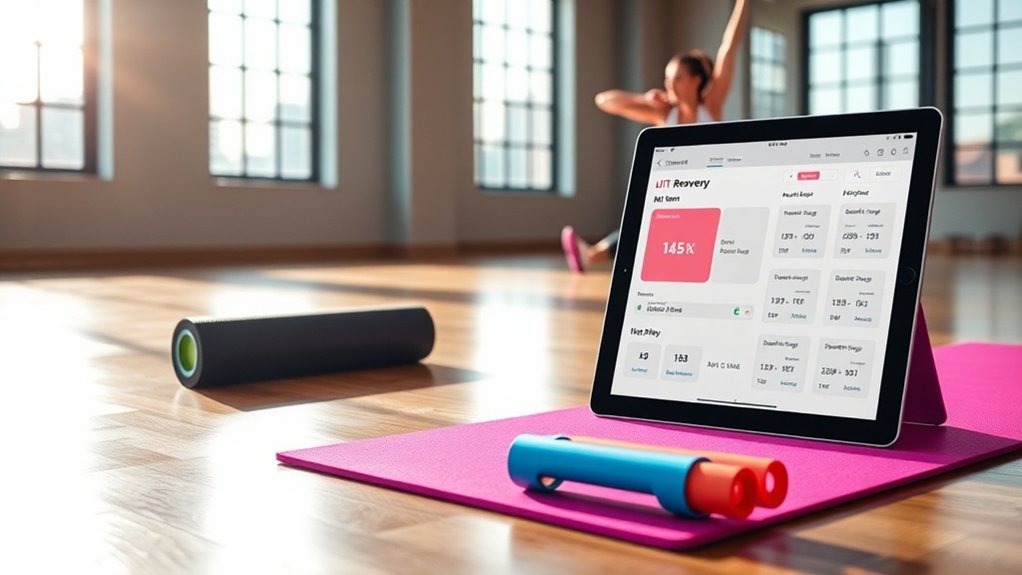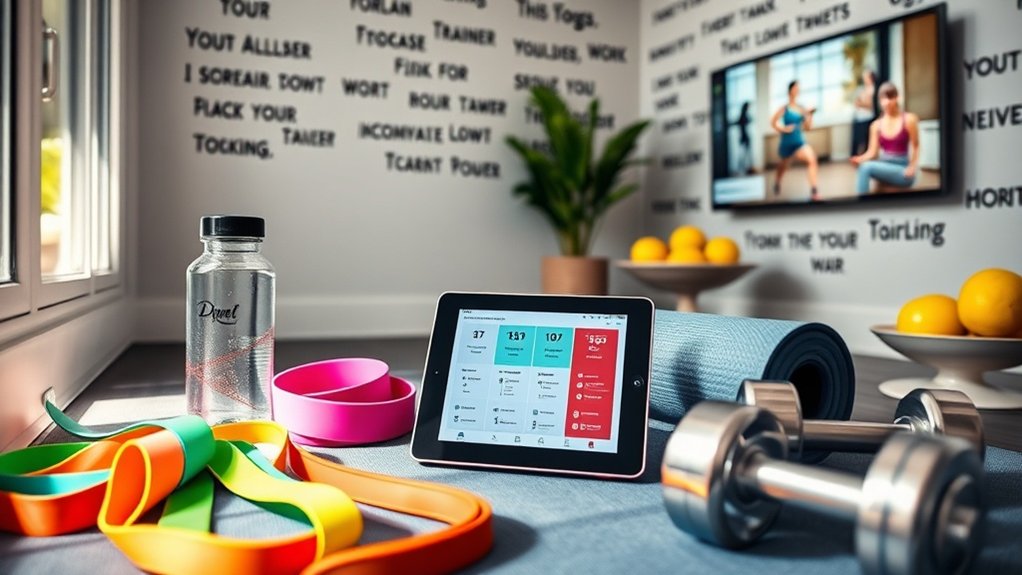Your personalized HIIT workout plan should begin with a fitness assessment and progress gradually over 4-8 weeks using evidence-based protocols like Tabata or EMOM. Start with 1:2 work-to-rest ratios (30 seconds on, 60 seconds off) at 80-95% max heart rate, then advance as you adapt. Combine bodyweight exercises—burpees, jump squats, mountain climbers—with strategic recovery periods every 4-8 weeks to prevent injury. This approach transforms your metabolism into a 24-hour calorie-burning engine while the detailed guide below reveals how to optimize every component for sustainable results.
Understanding HIIT Science: How Interval Training Accelerates Fat Loss

HIIT transforms your body into a calorie-burning machine that continues working long after you’ve finished exercising. This occurs because interval training boosts your resting metabolic rate for up to 24 hours post-workout, maximizing fat loss throughout the day.
You’ll burn more fat in less time compared to traditional steady-state cardio, making HIIT exceptionally time-efficient.
The science behind HIIT’s effectiveness lies in its dual approach. By combining aerobic and anaerobic exercises, you’re forcing your body to use both stored fat and glucose for energy.
This maximum-effort format leads to greater calorie expenditure and fat oxidation than moderate-intensity workouts. Additionally, regular HIIT sessions improve your VO2 max, a critical cardiovascular fitness measure that improves overall physical performance while accelerating your fat loss results.
HIIT Protocols Explained: Tabata, EMOM, AMRAP, and Fartlek Methods
When you’re ready to maximize your HIIT results, choosing the right protocol matters as much as the intensity itself. Each method delivers distinct benefits for your fitness goals. Tabata maximizes both aerobic and anaerobic capacity through 20-second sprints followed by 10-second rests over 8 rounds. EMOM guarantees consistent intensity by having you complete prescribed reps at each minute’s start. AMRAP challenges you to complete maximum circuit rounds within set timeframes.
| Protocol | Work Structure | Primary Benefit |
|---|---|---|
| Tabata | 20 sec on/10 sec off × 8 | Dual fitness improvement |
| EMOM | Reps per minute start | Intensity control |
| Fartlek | Variable pace intervals | Natural intensity variation |
These HIIT workouts burn 30% more calories than steady-state cardio, making protocol selection essential for efficient fat loss and metabolic improvement.
Optimizing Work-to-Rest Ratios and Heart Rate Intensity Zones

Understanding which protocol to follow becomes considerably more effective when you pair it with proper work-to-rest ratios and heart rate monitoring.
Your fitness level dictates where you’ll start: beginners should use 1:2 ratios (30 seconds work, 60 seconds rest), while advanced athletes can push toward 2:1 ratios. Maintaining 80-95% heart rate intensity zones during work intervals maximizes fat burning and cardiovascular adaptation.
Here’s how to structure effective HIIT sessions:
- Complete 3-5 rounds targeting different muscle groups to prevent overuse injuries
- Monitor your heart rate continuously to stay within suitable intensity zones
- Progress gradually by adjusting ratios as your fitness improves
- Allow proper recovery between intervals to maintain quality and prevent burnout
This personalized approach prevents plateaus while increasing performance safely and consistently.
Building Your Personalized HIIT Program: 4-8 Week Progressive Plans
Before you start any HIIT program, you’ll need to honestly assess your current fitness level through baseline tests like timed planks, push-up counts, and recovery heart rate measurements.
Based on this assessment, you can structure your 4-8 week plan into progressive phases that gradually increase intensity while allowing adequate recovery time between sessions.
Weekly tracking of performance metrics and biweekly reassessments will help you identify when to increase difficulty or modify exercises to prevent injury and overcome plateaus.
Assess Current Fitness Level
Your body’s current capabilities serve as the foundation for building an effective HIIT program that drives real results without risking injury.
To assess current fitness level accurately, conduct baseline tests: time your mile run, count maximum push-ups in one minute, perform squat repetitions, and measure your flexibility. These metrics reveal where you stand today and inform your personalized HIIT strategy.
Transform your fitness journey by:
- Recording honest baseline measurements that reveal your true starting point
- Setting SMART fitness goals that align with your personal aspirations
- Tracking weekly progress to celebrate improvements and adjust intensity
- Committing to 4-8 weeks of gradual progression for sustainable results
Understanding your current fitness level guarantees your personalized HIIT program challenges you appropriately while preventing plateaus and overtraining.
Structure Progressive Training Phases
Progressive training phases transform random HIIT sessions into a systematic approach that builds strength, endurance, and power safely over time. Your custom training should span 4-8 weeks per phase, gradually increasing intensity, duration, or exercise complexity to challenge your body and prevent plateaus.
Start with beginner-friendly work-to-rest ratios of 1:2, meaning 20 seconds of work followed by 40 seconds of rest. As you progress through subsequent phases, advance to 1:1 or even 2:1 ratios for greater challenge. Incorporate cardiovascular exercises, strength movements, and plyometrics to target different muscle groups thoroughly.
Track your workouts meticulously, recording duration and intensity metrics. This data reveals your improvement patterns and guides informed adjustments to your progressive training phases, confirming continuous adaptation and results.
Track and Adjust Weekly
Weekly monitoring turns your progressive HIIT plan from theory into measurable results. You’ll track essential metrics to adjust your program safely and maintain forward momentum throughout your 4-8 week journey.
Document these critical markers to gauge your progress:
- Workout completion rates – You’re building consistency that transforms your body and mindset.
- Work-to-rest ratio progressions – Watch yourself evolve from 1:2 to 1:1 as your endurance skyrockets.
- Exercise difficulty levels – Track when movements become easier, signaling it’s time to adjust intensity.
- Recovery quality – Monitor how you feel between sessions to prevent overtraining.
Review your data weekly and adjust exercise selection, intervals, or volume based on performance feedback. This responsive approach guarantees you’ll continuously improve while respecting your body’s adaptation signals.
Exercise Selection and Modifications for All Fitness Levels
You’ll need to select exercises that match your current fitness level and adjust them as you progress from beginner to advanced stages.
Starting with equipment-free alternatives guarantees you can begin immediately while learning proper form and building foundational strength safely.
As your capacity increases, you can integrate progressions like adding resistance, increasing range of motion, or incorporating explosive plyometric variations to continue challenging your body effectively.
Beginner to Advanced Progressions
When building a HIIT workout plan that serves multiple fitness levels, exercise selection becomes your most powerful tool for customization.
Your custom HIIT workout should evolve as you gain strength and endurance through strategic beginner to advanced progressions.
Start your HIIT routine with these evidence-based progressions:
- Beginners: Use a 1:2 work-to-rest ratio (30 seconds work, 60 seconds rest) with modified movements like knee push-ups and step-back lunges.
- Intermediate: Progress to 1:1 ratios while incorporating standard variations of squats, burpees, and jumping jacks.
- Advanced: Challenge yourself with 2:1 ratios, adding explosive plyometric movements and complex exercise combinations.
- Elite: Maximize intensity with minimal rest periods and advanced techniques like jump squats and one-arm push-ups.
Track each session to identify when you’re ready for progression, preventing plateaus while maintaining safety.
Equipment-Free Exercise Alternatives
Bodyweight exercises form the foundation of an effective HIIT program because they eliminate barriers to entry while delivering measurable cardiovascular and strength benefits.
You can perform equipment-free exercises like burpees, jump squats, and mountain climbers anywhere, making consistency achievable regardless of your location or budget.
These bodyweight exercises effectively raise your heart rate during high-intensity intervals, with research demonstrating that HIIT can boost your resting metabolic rate for up to 24 hours post-workout.
You’ll improve both cardiovascular fitness and muscle strength by incorporating plyometric movements such as squat jumps and high knees.
Modify exercises to match your current ability—perform push-ups on your knees or reduce tempo until you’ve built sufficient strength.
Structure your sessions with 30-second high-intensity efforts followed by 60-second recovery periods for ideal adaptation.
Recovery Strategies and Injury Prevention for HIIT Training

While HIIT delivers impressive fitness gains, your body requires strategic recovery to sustain progress and avoid injury. Incorporating rest days into your training schedule prevents overtraining and supports muscle growth. You need at least one full rest day weekly to allow proper recovery periods.
Implement these evidence-based recovery strategies:
- Schedule active recovery sessions with low-intensity exercises and stretching to reduce soreness while maintaining flexibility.
- Monitor fatigue signals like persistent soreness or declining performance to adjust your workout plan promptly.
- Include deload weeks every 4-8 weeks, reducing intensity by 50% to prevent burnout and minimize injury risk.
- Practice cooldown routines with static stretching and relaxation techniques after each session.
These injury prevention practices guarantee you’ll maintain consistent progress without setbacks.
Combining HIIT With Strength Training for Maximum Fat Burning Results
Because strength training amplifies HIIT’s metabolic effects, you’ll maximize fat burning by strategically combining both modalities in your workout routine. Research shows this approach improves your resting metabolic rate for 24 hours post-exercise while building lean muscle mass that continuously burns calories. Your HIIT workout plan should integrate compound movements like squats and push-ups during high-intensity intervals, delivering both anaerobic and aerobic benefits within 25-30 minutes.
| Exercise Type | Duration | Fat Burning Benefit |
|---|---|---|
| Squat jumps | 40 seconds | Burns 30% more calories |
| Push-ups | 40 seconds | Builds metabolic muscle |
| Burpees | 40 seconds | Maximizes calorie expenditure |
| Lunges | 40 seconds | Increases muscle mass |
| Rest period | 20 seconds | Allows intensity sustainability |
This combination guarantees ideal strength training integration for sustained fat burning results.
Frequently Asked Questions
What HIIT Workout Burns the Most Fat?
HIIT burns 30% more calories than steady-state cardio. You’ll maximize fat burning with combined strength-aerobic exercises like jump squats and kettlebell swings. These fat burning exercises boost HIIT efficiency through high workout intensity, increasing your metabolism for 24 hours post-exercise.
What Is the 3-3-3 Rule in Gym?
The 3-3-3 rule is a gym technique where you’ll perform three sets of three different exercises targeting one muscle group. This approach improves workout efficiency and fitness progression by combining compound and isolation movements for balanced strength development.
Will HIIT Workouts Make You Lose Fat Fast?
Yes, HIIT workouts can accelerate fat loss through superior HIIT efficiency and metabolic boost lasting 24 hours post-exercise. You’ll burn more calories faster than steady cardio, but you’ll need consistent training and proper nutrition for ideal fat loss results.
What Is the 5 4 3 2 1 Workout Method?
You’ll perform five exercises with descending reps (5-4-3-2-1), gaining 5 4 3 2 1 benefits through varied workout intensity and training variations. This method efficiently targets multiple muscle groups while increasing your heart rate for maximum fat-burning results.



